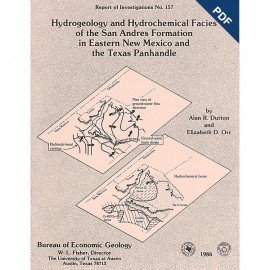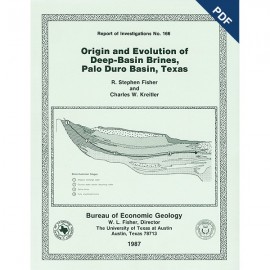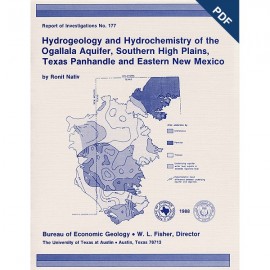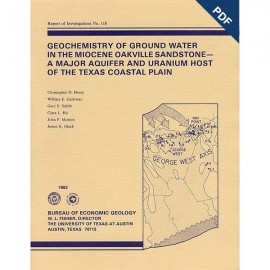Reports of Investigations
-
Books & Reports
- Reports of Investigations
- Guidebooks
- Udden Series
- Geological Circulars
- Down To Earth
- Atlases of Major Oil and Gas Reservoirs
- Texas Memorial Museum Publications
- Environmental Geologic Atlas of the Texas Coastal Zone
- Mineral Resource Circulars
- Other Reports
- Seminars and Workshops
- Handbooks
- Submerged Lands of Texas
- Symposia
- Annual Reports
- Open File Reports
-
Maps & Cross Sections
- Thematic Maps
- Miscellaneous Maps, Charts & Sections
- Geologic Atlas of Texas
- STATEMAP Project Maps
- Geologic Quadrangle Maps
- Cross Sections
- Highway Geology Map
- Energy and Mineral Resource Maps
- Shoreline Change and Other Posters
- Wilcox Group, East Texas, Geological / Hydrological Folios
- Bouguer Gravity Atlas of Texas
- River Basin Regional Studies
- Featured Maps
- Posters
- Teachers & the Public
-
Geological Society Publications
- Gulf Coast Association of Geological Societies
- Alabama Geological Society
- Austin Geological Society
- Corpus Christi Geological Society
- Houston Geological Society
- Lafayette Geological Society
- Mississippi Geological Society
- New Orleans Geological Society
- South Texas Geological Society
- GCS SEPM Publications
- Historic BEG & UT Series
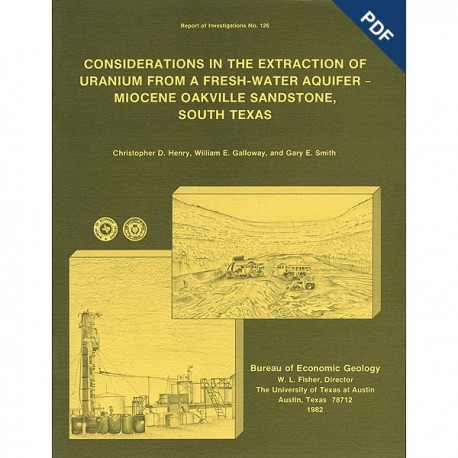
Considerations in the Extraction of Uranium from...Miocene Oakville Sandstone, South Texas. Digital Download
RI0126D
A free, digital version of this publication can be found on: Texas ScholarWorks
To purchase a print version (if available): RI0126
RI0126D. Considerations in the Extraction of Uranium from a Fresh-Water Aquifer: Miocene Oakville Sandstone, South Texas, by C. D. Henry, W. E. Galloway, and G. E. Smith. 36 p., 12 figs., 4 tables, 1 appendix, 1982. doi.org/10.23867/RI0126D. Downloadable PDF.
To purchase this publication in book format, please order RI0126.
ABSTRACT
The Miocene Oakville Sandstone is a major aquifer and uranium host beneath the Texas Coastal Plain. In 1976, approximately 6,000 acre-ft of ground water were withdrawn from the Oakville for municipal use. An additional but unknown amount was used for drinking water in rural areas, for livestock, and for irrigation. Potential sustained yield is many times greater. Present and future uranium mining by either surface or in situ methods could affect the availability and quality of Oakville ground water unless the mining is designed properly. This report discusses possible effects of mining, potential natural mitigation of these effects, and approaches to minimizing the impact of mining on the aquifer system. Conclusions are based on results presented in a series of reports, cited in following sections of this report, on physical stratigraphy, hydrology, and geochemistry of the Oakville Sandstone.
Both solution and surface mining may affect the availability of ground water by altering recharge characteristics and permeability. Because the volume of the aquifer affected by mining is small compared with its total volume, availability of Oakville ground water will probably not be reduced significantly, except in wells immediately adjacent to a mine. Mining may affect the quality of ground water by introducing chemicals that are not indigenous to the aquifer or by inducing chemical reactions that do not occur naturally or that occur at much slower rates. For example, most mining companies no longer use concentrated, ammonium-based leaches because of known problems in restoring water to its original chemistry. Natural and induced release of trace elements such as molybdenum is known to occur, but the geochemical controls on mobility and potential mitigating reactions in the aquifer are poorly understood.
Because the affected aquifer volume is small, any deterioration of water quality will probably be localized.
Observations and recommendations are presented on (1) regional and local baseline studies, (2) determination of aquifer sensitivity, (3) methods and goals of monitoring during and after mining, and (4) need for research on poorly understood aspects of mining impact. Such impacts include chemical reactions and processes that affect the long-term release of trace elements.
Keywords: aquifers, mining, Miocene, Oakville, South Texas, Texas Coastal Plain, uranium
CONTENTS
ABSTRACT
INTRODUCTION
URANIUM MINERALIZATION
URANIUM EXTRACTION PROCESSES
THE OAKVILLE AQUIFER
GEOLOGIC SETTING
USE OF OAKVILLE GROUND WATER
Current pattern of water use
Climate
Regional land use
INTERACTION OF MINING AND GROUND WATER
LIXIVIANT-MATRIX REACTIONS
POSSIBLE ALTERATION OF WATER QUALITY
Abandonment and restoration of solution mines that used an alkaline or neutral leach
Long-term effects
Excursion of an alkaline leach fluid
Acid leach fluids
QUANTIFICATION OF MINING IMPACTS
George West district
Ray Point district
OBSERVATIONS AND RECOMMENDATIONS
ACKNOWLEDGMENTS
REFERENCES
APPENDIX
FIGURES
1. Depositional elements of the Oakville fluvial system, central and southern Texas Coastal Plain
2. Stratigraphic section, South Texas uranium province
3. Uses of Oakville water, South Texas
4. Land and water use in the Oakville aquifer area, South Texas
5. Climatic variations within Oakville outcrop
6. Existing land use and vegetation zones within study area
7. Possibilities for the flow of water across or within geochemical zones of a uraniferous aquifer
8. Geologic setting, uranium deposits and mine areas, and interpreted direction of modern ground-water flux within the mineralized lower Oakville aquifer, George West district
9. Geologic setting, uranium deposits and mine areas, and interpreted direction of modern ground-water flux within the mineralized basal Oakville sand unit, Ray Point district
10. Dip-oriented cross section of Oakville sand, Ray Point district
11. Computer simulation of ground-water flow in a faulted aquifer-aquitard sequence
12. Summary of Oakville hydrology, land use, and consequent inferred aquifer sensitivity, South Texas Coastal Plain
TABLES
1. Public use of Oakville ground water
2. Average and range of Oakville ground-water quality
3. Analysis of in situ leach fluid, Oakville Sandstone, South Texas
4. Measured and calculated physical hydrologic parameters of principal Oakville mining districts
APPENDIX
Oakville water wells
Citation
Henry, C., Galloway, W. E., and Smith, G. E., 1982, Considerations in the Extraction of Uranium from a Fresh-Water Aquifer: Miocene Oakville Sandstone, South Texas: The University of Texas at Austin, Bureau of Economic Geology, Report of Investigations No. 126, 36 p.

